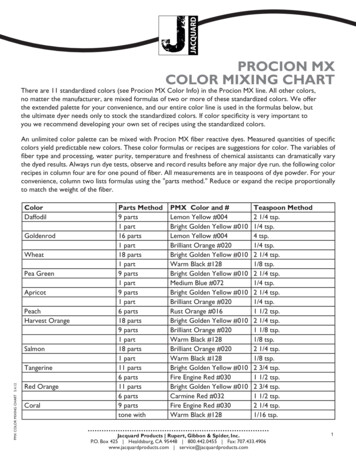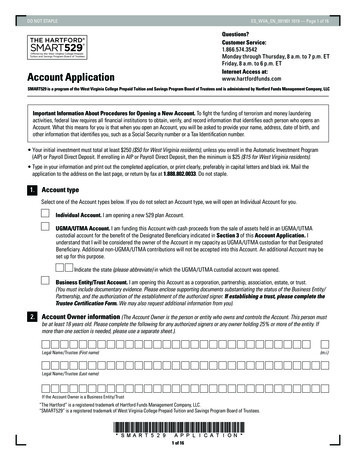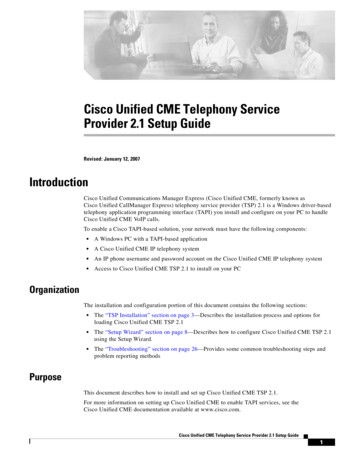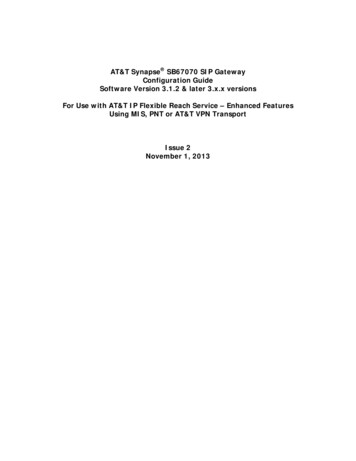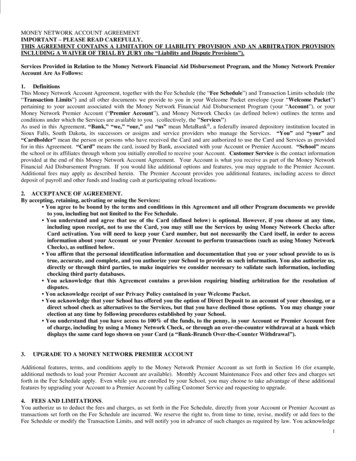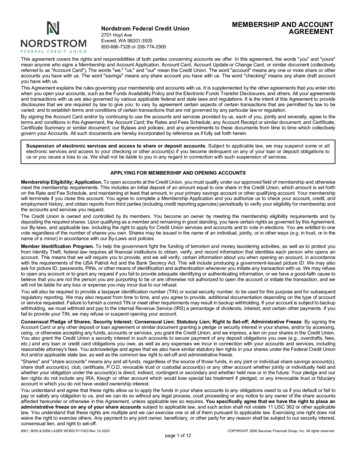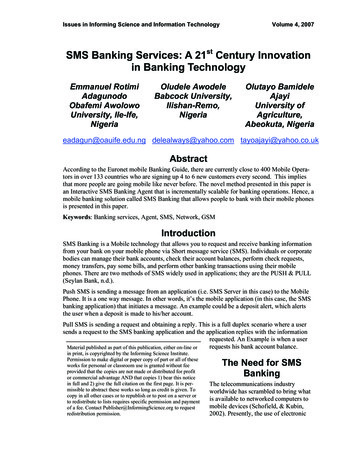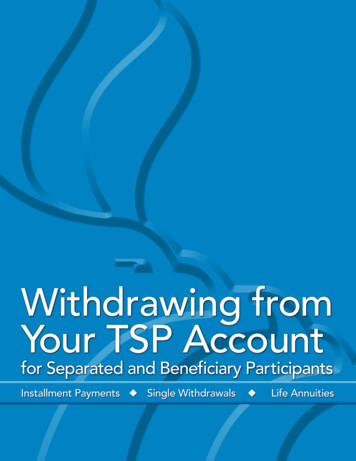
Transcription
Withdrawing fromYour TSP Accountfor Separated and Beneficiary ParticipantsInstallment Payments Single Withdrawals Life Annuities
Contact InformationTSP Website:ThriftLine:TSP Mailing Address:tsp.gov1-877-968-3778(For calls outside the U.S., Canada, andmost U.S. territories, use 404-233-4400.)Thrift Savings PlanP.O. Box 385021Birmingham, AL 35238Text Telephone (TDD):1-877-847-4385TSP Fax:1-866-817-5023
Table of ContentsIntroduction. . . . . . . . . . . . . . . . . . . . . . . . . . . . . . . . . . . . . . . . . . . . . . . . . . . . . . . . . . . 1Questions to Ask Before Withdrawing from Your Account. . . . . . . . . . . . . . . . . . . . . . . . . . . . 1Tailoring Your Withdrawal Decisions to Your Personal Needs. . . . . . . . . . . . . . . . . . . . . . . . . . 1Leaving Your Money in the TSP. . . . . . . . . . . . . . . . . . . . . . . . . . . . . . . . . . . . . . . . . . . . . . . 2Your Withdrawal Options. . . . . . . . . . . . . . . . . . . . . . . . . . . . . . . . . . . . . . . . . . . . . 2Withdrawal Methods. . . . . . . . . . . . . . . . .Traditional, Roth, or Both. . . . . . . . . . . . . .Taxes on TSP Withdrawals . . . . . . . . . . . . .Transferring Your Withdrawal. . . . . . . . . . .Withdrawal Rules for Rehired Participants. .Requesting Your Withdrawal. . . . . . . . . . . .The Timing of Your Withdrawal . . . . . . . . .Changing Your Withdrawal Election . . . . . . . . . . . . . . . . . . . . . . . . . . . . . . . . . . . . . . . . . . 2. . . . . . . . . . . . . . . . . . . . . . . . . . . . . . . . . . . . . 4. . . . . . . . . . . . . . . . . . . . . . . . . . . . . . . . . . . . . 4. . . . . . . . . . . . . . . . . . . . . . . . . . . . . . . . . . . . . 4. . . . . . . . . . . . . . . . . . . . . . . . . . . . . . . . . . . . . 5. . . . . . . . . . . . . . . . . . . . . . . . . . . . . . . . . . . . . 6. . . . . . . . . . . . . . . . . . . . . . . . . . . . . . . . . . . . . 6. . . . . . . . . . . . . . . . . . . . . . . . . . . . . . . . . . . . . 7Special Considerations. . . . . . . . . . . . . . . . . . . . . . . . . . . . . . . . . . . . . . . . . . . . . . . . 7Vesting Requirements. . . . . . . . . . . . . . . . . .Spouses’ Rights. . . . . . . . . . . . . . . . . . . . . .Account Holds. . . . . . . . . . . . . . . . . . . . . . .Death Benefits. . . . . . . . . . . . . . . . . . . . . . .Required Minimum Distributions. . . . . . . . .Participants with Two TSP Accounts . . . . . . .Reporting Changes in Personal Information. . . . . . . . . . . . . . . . . . . . . . . . . . . . . . . . . . . . . 7. . . . . . . . . . . . . . . . . . . . . . . . . . . . . . . . . . . . 7. . . . . . . . . . . . . . . . . . . . . . . . . . . . . . . . . . . . 8. . . . . . . . . . . . . . . . . . . . . . . . . . . . . . . . . . . . 8. . . . . . . . . . . . . . . . . . . . . . . . . . . . . . . . . . . . 8. . . . . . . . . . . . . . . . . . . . . . . . . . . . . . . . . . . . 9. . . . . . . . . . . . . . . . . . . . . . . . . . . . . . . . . . . . 9Glossary of Terms. . . . . . . . . . . . . . . . . . . . . . . . . . . . . . . . . . . . . . . . . . . . . . . . . . . .11TSP Materials for Separatedand Beneficiary Participants . . . . . . . . . . . . . . . . . . . . . . . . . . . . . . . . . . . . . .13i
IntroductionThis booklet describes the choices that are available toall separated participants and beneficiary participants. Inthis booklet, a “separated participant” means someonewho established a Thrift Savings Plan (TSP) accountwhile serving as a civilian federal employee or memberof the uniformed services and has now separated fromthat employment. A “beneficiary participant” is a spousebeneficiary of a deceased civilian or uniformed servicesTSP participant who has a TSP account establishedin his or her name. In this booklet, you will findinformation about the withdrawal process, the rules thatgovern withdrawals, and the tax implications of eachwithdrawal option.Before you decide to withdraw money from your TSPaccount, we recommend that you consider how yourdecision may impact your future needs. For example,if you are not ready to retire and are consideringusing the money in your TSP account for purposesother than your future retirement needs, you shouldconsider the tax implications and whether you will haveenough retirement savings when you are ready to retire.Alternatively, if you are retiring or retired, you shouldthink about when you will actually need the money inyour TSP account and whether the withdrawal choicesyou make will provide enough income throughout yourretirement years.Questions to Ask BeforeWithdrawing from Your AccountGiven that you may need your retirement savings intoyour 90s, here are some questions you should askyourself before deciding to withdraw your TSP account. When should I begin withdrawing my money?How much do I think things will really cost duringmy retirement?Will I have enough income to cover my expensesafter I retire?Will my retirement savings last for my whole life?Do I need to provide income for my dependents/heirs?Because of inflation, the goods and services you buytoday will probably cost you more in the future. Onceyou are living on a fixed income, increases in the cost ofliving can make meeting even the most basic expenseschallenging. Even a relatively low rate of inflation canhave a significantly diminishing effect on the purchasingpower of your retirement savings. The following chartshows how your account may be affected by seeminglymodest inflation. Suppose that the value of youraccount thirty years from now is 150,000. An inflationrate of 2% per year would reduce that 150,000 to thepurchasing power of only 82,811 today. Notice that thehigher the average rate of inflation, the less purchasingpower you’ll have.Decline in Purchasing Power over 30 Years 150,000 120,000 90,0002.0% 60,000152.5%10 82,8113.0%15202530 71,511 61,798YearsIt’s important to estimate the amount of money youneed to put aside for retirement to maintain yourpreretirement standard of living. Financial advisorstypically refer to this calculation as a retirementincome replacement ratio, or the percentage of yourpreretirement income that you need in retirement.Experts will often recommend a range of numbers, buteach person’s situation is unique. You also want to becareful that you do not withdraw too much moneyfrom your retirement account each year. Many retireesdo, and they risk spending their savings too quickly.To avoid running out of money in retirement, plannersoften recommend withdrawing no more than 4% of yourretirement savings during your first year of retirementand adjusting that amount annually for inflation.Tailoring Your WithdrawalDecisions to Your Personal NeedsThere are other factors besides life expectancy thatyou should take into consideration when making yourwithdrawal decisions. For example: What additional sources of income will you haveoutside of your TSP account?Will you be paying off a mortgage during yourretirement?Will you be moving to an area where your expenseswill be significantly higher or lower than where youlived before you retired?1
Everyone’s withdrawal choices will bebased on different circumstances. Theimportant thing is to make sure yourdecisions are well informed and carefullythought through. The TSP has onlinecalculators available at tsp.gov to help you.Leaving Your Money in the TSPUnless you’re subject to required minimum distributions1or you have a balance of less than 200,2 there’s norequirement for you to make withdrawals from youraccount. So you can leave your entire account balancein the TSP and continue to enjoy tax-deferred earningsand our low administrative expenses. You won’t be ableto make employee contributions, but your accountwill continue to accrue earnings, and you can continueto change the way your money is invested in the TSPinvestment funds by making interfund transfers.If you’re a separated participant, you can alsotransfer money into your TSP account fromtraditional and Roth eligible employer plans and fromtraditional IRAs. (Transfers from Roth IRAs are notallowed. Beneficiary participants are not allowed totransfer money in.)Your Withdrawal OptionsWithdrawal MethodsThere are three basic methods of withdrawing moneyfrom your TSP account as a separated or beneficiaryparticipant: installment payments, single withdrawals,and annuity purchases. Choosing one or more of thesemethods is not the only decision you’ll need to makewhen making a withdrawal, so be sure to read on afterthis section.1 See page 8 for information about required minimumdistributions.2 Separated participants, if your vested account balance is lessthan 200 after your agency or service reports that you have leftservice, your balance will be automatically paid directly to youin a single payment (i.e., cashout). You will not be allowed toremain in the TSP. We will not withhold any amount for federalincome tax on your cashout if all your withdrawals from the TSPthroughout the year of your cashout add up to less than 200.If your balance is less than 5.00 when you leave service, we willautomatically forfeit the balance to the Thrift Savings Plan. Yourquarterly participant statement will indicate that the balance hasbeen forfeited. You can reclaim the forfeited amount by sendingus a written request, but we will not credit earnings to theaccount after the forfeiture date.2TSP Installment PaymentsYou can choose to receive payments from your accountmonthly, quarterly (every three months), or annually.Your payments will continue, unless you stop them,until your total account balance equals zero. This is trueeven if you choose to have the payments come fromyour traditional balance first or from your Roth balancefirst. When you run out of money in your chosen source(traditional or Roth), payments will continue from thesource you didn’t choose. See “Traditional, Roth, orBoth” on page 4.There are two ways of setting the payment amount:payments of a fixed dollar amount and payments basedon life expectancy.Fixed Dollar AmountYou can choose the amount you want to receive in eachpayment as long as it’s at least 25.Life ExpectancyYou can have us compute your installment paymentsbased on IRS life expectancy tables. Your initialpayment amount will be based on your age and youraccount balance at the time of the first payment. Lifeexpectancy payments are calculated using your entireaccount balance even if you choose to withdraw fromyour Roth balance first or your traditional balance first.(See “Traditional, Roth, or Both” on page 4.) If youchoose life-expectancy-based installment paymentsin combination with a single withdrawal, an annuitypurchase, or both, your payment calculation will bemade after the other funds are removed from youraccount. Each January, we will recalculate the amountof your installment payment. The recalculation will bebased on your age and your account balance at the endof the preceding year.Use the “TSP Installment Payment Calculator” attsp.gov to estimate the amount of your life expectancypayments or to see how long payments of a fixed dollaramount would last. Remember that investment gainsor losses and other account activity could cause youraccount balance to increase or decrease, which couldincrease or decrease either the amount of your lifeexpectancy payments or the duration of your fixeddollar-amount payments.
Making Changes toYour Installment PaymentsAfter your installment payments are set up, you canmake changes to them at any time. See page 7 forinformation on how to make changes.You can make the following changes whether you’rereceiving payments of a fixed dollar amount or based onlife expectancy: stop paymentschange the source of payments (traditional, Roth,or both)start, stop, or change direct deposit of yourpaymentschange your federal tax withholdingThe following changes can only be made if yourpayments are of a fixed dollar amount: You are not permitted to transfer any part of yourpayments to an IRA or eligible employer plan.For annual payments:Balance Payment AmountFor quarterly payments:(Balance Payment Amount) 4For monthly payments:(Balance Payment Amount) 12change or stop transfers (if currently transferring)If the expected duration of your payments is lessthan 10 years, the following IRS rules apply:You can instruct us to waive withholding, withholdbased on your marital status and allowances, orwithhold an additional amount.To determine the expected duration of your fixed-dollaramount payments, we divide your account balance bythe amount of your payment:start transferring your payments to an IRA oreligible employer plan (only if payments areexpected to last less than 10 years)The rules for federal tax withholding and eligibility totransfer to an IRA or eligible employer plan are differentdepending on how long your payments are expected tolast.We must withhold for federal income tax as if youare married with three dependents.See the TSP tax notice Important Information AboutPayments From Your TSP Account for more information.change the frequency of your paymentsInstallment Payments Lasting Less Than 10Years vs. Payments Lasting 10 Years or MoreYou are permitted to transfer all or part of yourpayments to an IRA or eligible employer plan.If the expected duration of your payments is 10 yearsor more or they are based on life expectancy,3 thefollowing IRS rules apply:change the dollar amount of your paymentsImportant: Note that changing the amount orfrequency of your payments is not valid for paymentsbased on life expectancy. So we will change yourpayments to fixed-dollar-amount payments if yourequest such a change. We do not consider potential earnings or losses whencalculating the expected duration of your payments.The following events will trigger a recalculation ofyour expected payment duration: You change the dollar amount or frequency of yourpayments.You transfer money into your TSP account.You take a withdrawal or purchase an annuity inaddition to your installment payments.If the recalculation changes the expected paymentduration from less than 10 years to 10 years or more,or vice versa, the rules that apply to your payments willchange.We must withhold 20% of any amount that you donot transfer for federal income tax.You can instruct us to withhold an amount inaddition to the 20% default withholding.We cannot waive withholding or withhold any lessthan 20%.3 Payments based on life expectancy are treated the same asfixed-dollar-amount payments lasting 10 years or more,regardless of your age.3
Single WithdrawalYou can withdraw any amount of 1,000 or more fromyour account in a single payment. There is no limit onthe number of single withdrawals you can make, but wewill not process more than one in any 30-day period. Youare allowed to take a single withdrawal of part of youraccount even if you’re currently receiving installmentpayments.Purchase an AnnuityYou can use all or part of your TSP account to purchasea life annuity through our outside vendor. Purchasingan annuity means that you pay now to receive monthlypayments that last for the rest of your life (or, if youchoose a joint life annuity, the life of your jointannuitant). The money you use to purchase a lifeannuity is no longer managed by you; it’s not like yourTSP account, an IRA, a CD, or a bank account. You giveup your money and the control of it in exchange forguaranteed lifetime monthly payments. If you choosethis option, we will purchase an annuity for you fromour annuity provider. Your annuity is not part of yourTSP account. The minimum for an annuity purchase is 3,500. The minimum applies to your traditional andyour Roth balances separately. See the TSP fact sheetAnnuities, available at tsp.gov, for more information.Traditional, Roth, or BothIf you have both traditional and Roth money in youraccount, you can specify that your withdrawal shouldcome only from your traditional money or only fromyour Roth money. This is optional. If you don’t specify,then your withdrawal will be made from both types “prorata,” meaning it will have the same percentages of Rothand traditional as are in your account.Example of a pro rata withdrawal: Your totalaccount balance is 150,000, of which 120,000 (80%)is traditional and 30,000 (20%) is Roth. You request awithdrawal of 10,000, and you don’t specify traditionalor Roth. Your withdrawal will consist of 8,000 (80%) oftraditional money and 2,000 (20%) of Roth money.Taxes on TSP WithdrawalsYour TSP withdrawal may be subject to federal incometaxes. The tax treatment of your withdrawal dependson the type of balance (traditional, Roth, or both) fromwhich your withdrawal is taken as well as the withdrawal4method that you choose. For detailed informationabout the tax rules, read the TSP tax notice ImportantTax Information About Payments From Your TSP Account,available at tsp.gov or by calling the ThriftLine.Special Note for UniformedServices MembersIf you have a uniformed services TSP account, or abeneficiary participant account created from yourspouse’s uniformed services account, your accountmay include tax-exempt contributions as a result ofdeployment to a combat zone. These contributionsare always exempt from federal income taxes. The taxtreatment of earnings on tax-exempt money dependson whether they’re in a traditional balance or a Rothbalance. Earnings on tax-exempt money in yourtraditional balance will be subject to tax at the time thatyou make a withdrawal. The earnings on tax-exemptmoney in your Roth balance will not be taxed if theyare qualified.4 See the TSP tax notice Important TaxInformation About Payments From Your TSP Account for adetailed explanation.Note: Withdrawals from a uniformed servicesaccount traditional balance will be paid pro rata (i.e.,proportionally) from taxable and nontaxable amounts.Transferring Your WithdrawalYou can transfer part or all of your single withdrawal oreligible installment payments to an IRA or an eligibleemployer plan (for example, the 401(k) plan of a newemployer). Check with the IRA provider or the otherplan’s administrator to see if it can accept your transfer.Any tax-deferred amounts that are transferred will retaintheir tax-deferred status until you withdraw your money.Note: You can transfer traditional money to a Roth IRA,but you will have to pay taxes on the amount transferredat the time you transfer it. You cannot transfer Rothmoney to a traditional IRA since that would result inyour paying taxes on the same money twice, once before itwent into your Roth TSP and once when you withdraw itfrom the traditional IRA.4 Roth earnings become qualified (i.e., paid tax-free) when thefollowing two conditions have been met: (1) 5 years have passedsince January 1 of the calendar year in which you made your firstRoth contribution and (2) You have reached age 59½ or havea permanent disability or in the case of your death. Note: Wecannot certify to the IRS that you meet the Internal RevenueCode’s definition of a disability when your taxes are reported.Therefore, you must provide the justification to the IRS when youfile your taxes.
Single withdrawal. If you have only one type of balance(traditional or Roth) in your single withdrawal, you candirect all or part of it to only one IRA account or eligibleemployer plan. If you have both traditional and Rothbalances in your withdrawal, you can direct all or partof the traditional portion to one IRA or plan, and all orpart of the Roth portion of the payment to another IRAor plan (assuming you meet the eligibility requirementsof the receiving plan(s)). We will pay any amounts nottransferred directly to you either by check or directdeposit.When requesting a transfer, be sure touse the transfer pages provided by theTSP. Do not use forms provided by thenew plan or financial institution.TSP installment payments. If your TSP installmentpayments are eligible, you can choose to have ustransfer them to an IRA or eligible employer plan. Yourinstallment payments are eligible if they’re expectedto last less than 10 years and are not based on lifeexpectancy. See page 3.Transferring tax-exempt TSP balances. Tax-exemptbalances resulting from contributions from pay earnedin a combat zone may also be transferred or rolled overinto an IRA or transferred to an eligible employer plan.Traditional IRAs must certify that they accept taxexempt money in order for us to make the transfer. Weare allowed to transfer tax-exempt money from youraccount only if you have no taxable money left. If youhave some taxable money but not enough to satisfy thepercentage that you elected to transfer, we will transferthe taxable money first and then transfer enough taxexempt money to make up the difference.The tax rules surrounding transfers and rollovers oftraditional and Roth balances are complex. For moreinformation, read the TSP tax notice Important TaxInformation About Payments From Your TSP Account. Youshould also consider speaking with a qualified taxadvisor before making your decision.Depositing YourPayment(s) ElectronicallyAs with single withdrawals, if you have only one type ofbalance (traditional or Roth) in your payment, you candirect all or part of your eligible installment paymentsto only one IRA account or eligible employer plan. Ifyou have both traditional and Roth balances in yourpayment, you can direct all or part of the traditionalportion to one IRA or plan and all or part of the Rothportion of your eligible installment payment to anotherIRA account or plan (assuming you meet the eligibilityrequirements of the receiving plan(s)). We will pay anyamounts not transferred directly to you either by checkor direct deposit.Any single payment or installment payment that is nottransferred directly to an IRA or an eligible employerplan can be sent to your checking or savings accountelectronically by direct deposit. You can have yourpayment(s) sent electronically to only one checking orsavings account at one financial institution. This is trueeven if you have traditional and Roth money in yourwithdrawal.If your plan or financial institution needs us to certifythat the money you are transferring is eligible for transfer,you can provide it with a copy of the fact sheet TransfersFrom the Thrift Savings Plan to Eligible Retirement Plans. It isavailable at tsp.gov or by calling the ThriftLine.If you separate from federal civilian employment orthe uniformed services and then are reemployed by thefederal government with a break in service of less than31 full calendar days, you are not eligible to make postseparation withdrawals from your TSP account. If yourbreak in service is 31 or more full calendar days, youare eligible, but not required, to make a post-separationwithdrawal, but the withdrawal request must be receivedand paid while you are still separated from service.Rolling over your withdrawal. We will pay anyamounts not transferred directly to you either by checkor direct deposit, and you will be subject to federal taxwithholding on any taxable amounts. Within 60 daysof receiving payment, you can still send it to an IRA oreligible employer plan. When you make the transactionthis way, it’s called a rollover.5Withdrawal Rules forRehired ParticipantsNote: If you began receiving TSP installment paymentsafter you separated, those payments will stop if youare subsequently rehired. However, if you are receivingannuity payments, they will continue even thoughyou’ve been rehired.5 The IRS may waive the 60-day rollover requirement in certainsituations if you missed the deadline because of circumstancesbeyond your control.5
Requesting Your WithdrawalOnce you’ve read this booklet and the TSP tax noticeImportant Tax Information About Payments From Your TSPAccount and are ready to request a withdrawal, log intoMy Account at tsp.gov and click on the “Withdrawalsand Changes to Installment Payments” link on themenu. From there you’ll have access to an online toolwith which to start your withdrawal.If you’re trying to make a withdrawal as a separatedparticipant, your former agency or service must havegiven us your separation date before you’ll be allowedto proceed with your request. Also, if you have anoutstanding TSP loan, the online tool will ask if youwant to keep the unpaid balance and have it declared ataxable distribution before allowing you to proceed. Ifyou want to pay off the loan instead, you’ll have to dothat before requesting a post-separation withdrawal. Seethe TSP booklet Loans for more information.When you begin your request, you’ll be asked whetheryou intend to withdraw just part of your account or yourtotal account balance.Withdrawing Part of Your AccountIf you decide to withdraw part of your account and leavethe rest in the TSP, you’ll be given all of the optionsdescribed under “Withdrawal Methods” beginning onpage 2: TSP installment payments, single withdrawal,and annuity purchase. Remember that you can chooseany of these three methods or any combination of them.For each method you choose, you’ll be asked if you wantto withdraw from your traditional balance or your Rothbalance. If you choose neither but have both types ofbalances, the withdrawal will be made pro rata fromboth. (See page 4.) You’ll only be asked this if you haveboth traditional and Roth money in your account.If you choose installment payments or a single withdrawal,you’ll also be asked if you intend to transfer any partof your withdrawal. The online tool will stop you fromtransferring any ineligible payments.Withdrawing All of Your AccountIf you choose to withdraw your total account balance,you’ll be asked if you want to receive it as a singlepayment, an annuity purchase, or a combination of thetwo. (TSP installment payments are not an option sincethey continue to leave money in your account.)6If you elect to receive your total account balance as asingle payment or as an annuity purchase, the questionof traditional, Roth, or both becomes irrelevant. We’ll useall the money you have. But if you ask for a combinationof the two methods and have both types of money inyour account, you’ll be asked if you’d like the annuity tobe purchased with only traditional money or only Rothmoney. The online tool will only ask this if you have bothtypes.If a single payment is part of your withdrawal, you’ll beasked if you intend to transfer all or part of it.Additional Informationfor Transfers and AnnuitiesIf you indicate you want to transfer all or part of yourwithdrawal or purchase an annuity, you’ll need toprovide additional information. See pages 4 and 5 formore information.Additional Options forYour Withdrawal RequestAt the time you request your withdrawal, you’ll be ableto request direct deposit and change the default federaltax withholding rate for any payment made directly toyou.Finalizing Your RequestWhen you’ve completed your online request, you’ll beasked to submit it online if possible. If your signatureor your spouse’s signature is required, you’re purchasingan annuity, or you’re transferring any part of yourwithdrawal, you won’t be able to complete the processentirely online. You’ll be given a summary of yourrequest, which you—and your spouse or financialinstitution if necessary—will need to sign, havenotarized, and then mail or fax to us. When we receivethese properly completed pages, we’ll be able to completethe transaction you began online.The Timing of Your WithdrawalIt generally takes between 7 to 10 business days toprocess your request once you’ve properly completed andsubmitted it. We disburse withdrawals each business day.You can check My Account at tsp.gov or call the ThriftLineto find out the status of your withdrawal request, includingwhether the payment has been made. We will also notifyyou after your payment has been disbursed.
Changing Your Withdrawal ElectionBefore payments begin. We process withdrawals eachbusiness day. Completed withdrawal requests that areentered into our system by 12:00 noon eastern timeare processed that night. This means that there is avery small window of time during which you would beable to cancel your request and submit a new election.Therefore, we recommend that you carefully consideryour options before submitting a withdrawal request.After payments begin. You cannot reverse a paymentthat has already been processed. Also, if you have chosenan annuity, you cannot change either the annuity optionor—if you’ve chosen a joint annuity—your choice ofjoint annuitant after we have processed your annuitypurchase.If you are receiving TSP installment payments.Remember, you can make changes to those paymentsat any time. See page 3 for details on what changes areallowed.As with your initial withdrawal request, use the onlinetool that you will find in My Account at tsp.gov byclicking “Withdrawals and Changes to InstallmentPayments.” When you’ve completed your online request,you’ll be asked to submit it online if possible. If yoursignature or your spouse’s si
change the frequency of your payments start transferring your payments to an IRA or eligible employer plan (only if payments are expected to last less than 10 years) change or stop transfers (if currently transferring) Important: Note that changing the amount or frequency of your payments is

